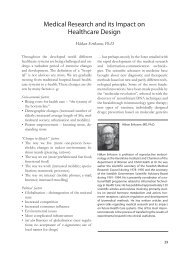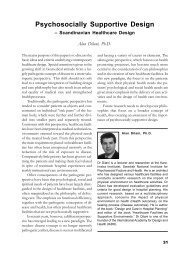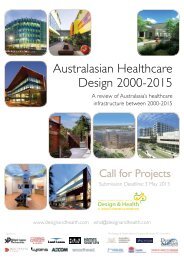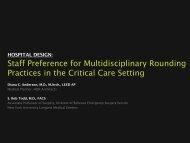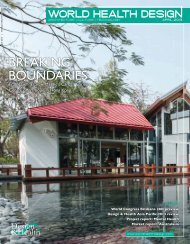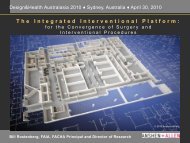SUPER GREEN - the International Academy of Design and Health
SUPER GREEN - the International Academy of Design and Health
SUPER GREEN - the International Academy of Design and Health
- No tags were found...
Create successful ePaper yourself
Turn your PDF publications into a flip-book with our unique Google optimized e-Paper software.
St<strong>and</strong>pointEach year, many billions <strong>of</strong> euros are spent on capital investment projects in <strong>the</strong> health sectoracross Europe, <strong>and</strong> this amount is likely to increase in <strong>the</strong> coming years, as many countriesface a backlog <strong>of</strong> maintenance <strong>and</strong> refurbishment.Nowhere is <strong>the</strong> need greater than in Central <strong>and</strong> Eastern Europe, where levels <strong>of</strong> capitalinvestment have been particularly low over <strong>the</strong> last 30-40 years.When funds become available to address <strong>the</strong> long-st<strong>and</strong>ing lack <strong>of</strong> capital investment – forexample through structural funds for new EU member states or <strong>the</strong> oil boom that countries likeRussia or Kazakhstan are experiencing – <strong>the</strong>re is a real danger that resources are not spent in <strong>the</strong>most effective <strong>and</strong> sustainable way. Before rushing into building new facilities, <strong>the</strong>re are some keylessons to be learnt from capital investment in Europe.What should precede any capital projects, is a comprehensive analysis <strong>of</strong> health needs <strong>and</strong> how<strong>the</strong>se needs should be translated into services <strong>and</strong> appropriate facilities. Long gone are <strong>the</strong> dayswhen hospital beds were seen as an indicator<strong>of</strong> a good healthcare system, such as under <strong>the</strong>Soviet Union, which placed great emphasis on alarge number <strong>of</strong> hospital beds <strong>and</strong> physicians.<strong>Health</strong> facilities should not be perceivedmainly in terms <strong>of</strong> buildings, beds or specialties,but ra<strong>the</strong>r from <strong>the</strong> perspective <strong>of</strong> <strong>the</strong> patientswho are treated in <strong>the</strong>m <strong>and</strong> <strong>the</strong> processesdelivered by <strong>the</strong> health pr<strong>of</strong>essionals who spend<strong>the</strong>ir working lives in <strong>the</strong>m.This approach entails going beyond <strong>the</strong> singlehealth facility <strong>and</strong> taking account <strong>of</strong> <strong>the</strong> wholetrajectory <strong>of</strong> care. Far too <strong>of</strong>ten, capacity planningin <strong>the</strong> health sector fails to move beyond hospitals<strong>and</strong> does not take account <strong>of</strong> <strong>the</strong> overall healthneeds <strong>of</strong> <strong>the</strong> population <strong>and</strong> <strong>the</strong> spectrum <strong>of</strong>health services required to meet those needs.<strong>Health</strong> facilities also <strong>of</strong>ten continue to be used beyond <strong>the</strong>ir functional lifespan <strong>and</strong> refl ect outdated patterns <strong>of</strong> care – such as <strong>the</strong>large number <strong>of</strong> tuberculosis hospitals throughout <strong>the</strong> former Soviet Union that are at odds with modern approaches to tuberculosistreatment. Flexibility must encompass all aspects <strong>of</strong> health facilities, including <strong>the</strong>ir scale <strong>and</strong> scope, architectural design, supportinginfrastructure, services to be provided, relationships with <strong>the</strong> rest <strong>of</strong> <strong>the</strong> health system, revenue fi nancing, <strong>and</strong> sources <strong>of</strong> capitalinvestment. Paradoxically, in a few countries, policy is moving in <strong>the</strong> opposite direction – <strong>the</strong> Private Finance Initiative in <strong>the</strong> UK involvescontracts, which are specifi ed in great detail for <strong>the</strong> lifetime <strong>of</strong> a project, usually around 30 years, with very little scope for change.Effective capital investment requires intelligent fi nancing mechanisms, both for services <strong>and</strong> capital. In terms <strong>of</strong> services, resourceallocation should reward outcomes ra<strong>the</strong>r than capacityThe cost, risks<strong>and</strong> value <strong>of</strong> capitalhave largely beenignored acrossEuropeLearning<strong>the</strong> lessonSuccessful capital projects in Europe require much morethan good architectural solutions, healing design <strong>and</strong>environmental sustainability, claims Bernd Rechel<strong>and</strong> provide a smooth patient journey across differentlevels <strong>of</strong> care. With regard to capital, <strong>the</strong> cost, risks <strong>and</strong>value <strong>of</strong> capital have largely been ignored across Europe,with investment <strong>and</strong> revenue costs belonging to differentstreams, removing any incentive for hospital managers tomanage assets effi ciently. This traditional split is graduallyeroding in many European countries, as hospitals areincreasingly becoming responsible for <strong>the</strong>ir capital assets.It is abundantly clear that successful capital projectsrequire much more than good architectural solutions, healing design <strong>and</strong> environmental sustainability. Theywill need to be based on an assessment <strong>of</strong> health needs, comprehensive capacity planning, a whole systemsperspective, systematised care pathways, anticipated fl exibility <strong>and</strong> intelligent fi nancing solutions. None <strong>of</strong> <strong>the</strong>countries in Europe has perfect solutions for all <strong>the</strong>se issues <strong>and</strong> those involved in planning major capital projectsare well advised to try <strong>and</strong> ensure <strong>the</strong> long-term effectiveness <strong>and</strong> sustainability <strong>of</strong> anticipated health facilities.Bernd Rechel is a lecturer at <strong>the</strong> London School <strong>of</strong> Hygiene & Tropical Medicine <strong>and</strong> a researcher at <strong>the</strong>European Observatory on <strong>Health</strong> Systems <strong>and</strong> Policies. He will be presenting a paper on ‘Hospitals <strong>of</strong> <strong>the</strong>Future: Improving <strong>the</strong> Effectiveness <strong>of</strong> <strong>Health</strong> Capital Investment’ at <strong>Health</strong>care Infrastructure 2008: BuildingBetter <strong>Health</strong>care in <strong>the</strong> Community on 2 December at <strong>the</strong> Savoy Place in London. For more information onthis event, which is endorsed by <strong>the</strong> <strong>International</strong> <strong>Academy</strong> for <strong>Design</strong> & <strong>Health</strong>, see p6.WORLD HEALTH DESIGN | October 2008 13



